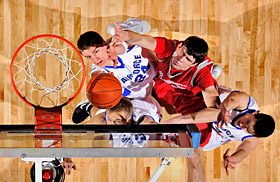 Hi and welcome to this packed edition of Workshop at the Ranch featuring Part II of the NEW Nikon D3X review. I felt the readers of Workshop at the Ranch might want some additional images and commentary on this remarkable piece of equipment. This month’s images are a wide variety ranging from the studio, to climbing along the Front Range of the Rocky Mountains, to indoor sports using the D3X with arena strobe lighting and remote camera work. With Nikon D3X Part I somewhat behind us, let’s review a few things I mentioned last month and then move on to some new pictures.
Hi and welcome to this packed edition of Workshop at the Ranch featuring Part II of the NEW Nikon D3X review. I felt the readers of Workshop at the Ranch might want some additional images and commentary on this remarkable piece of equipment. This month’s images are a wide variety ranging from the studio, to climbing along the Front Range of the Rocky Mountains, to indoor sports using the D3X with arena strobe lighting and remote camera work. With Nikon D3X Part I somewhat behind us, let’s review a few things I mentioned last month and then move on to some new pictures.
Hi and welcome to this packed edition of Workshop at the Ranch featuring Part II of the NEW Nikon D3X review. I felt the readers of Workshop at the Ranch might want some additional images and commentary on this remarkable piece of equipment. This month’s images are a wide variety ranging from the studio, to climbing along the Front Range of the Rocky Mountains, to indoor sports using the D3X with arena strobe lighting and remote camera work. With Nikon D3X Part I somewhat behind us, let’s review a few things I mentioned last month and then move on to some new pictures.
Last month’s article started out with plenty of data about the latest in the Nikon line of cameras and made some comparisons to the D3 and D700 in an effort to help photographers decide what camera might serve their needs best. The D3X boasts a 24.5 megapixel FX format and achieves a mid-format quality file in a familiar 35mm camera. I explained how at the 12 bit depth the D3X clock’s 5 fps, and at the ULTIMATE in quality of 14 bit depth it produces 2 fps, …(I use 14 bit if multiple frames are not needed.) I pointed out how you could use the crop mode and get 7 fps with a file size of 10.5 megapixels which is nearly a D3 file size. And I also mentioned that the higher ISO settings like 1600 or higher were not quite as clean as a D3 or D700, but looked very good none the less. The price of $7,499 for the D3X is a lofty sum and clearly is a difference that might hold some people back from the purchase, but I spent a lot of time and ink last month putting down into words why I think the purchase is justified, and believe in what I said as strong food for thought.
Even though the price tag of $7,499 is high compared to $4,399 for a D3 or even $2,699 for a D700, I felt my purchase of a D3X was more than justified and last month listed many examples of why I own a D3X. I listed the superior image quality as my #1 reason and went on to elaborate on what that superior image quality will do for my images and my business. Commercial/Advertising work pays far and away more than editorial work and so I promoted the need for the mid-format quality of the D3X as a standard in that side of the industry. But, I spent a lot of time discussing how I have always based my business on striving for the best image quality available, and how I’m always trying to raise the bar above were my colleagues and competitors are willing or able to go. It’s just basic business to try and out do the other guy and I can do so by using a D3X whenever possible.
Well, this past month has rolled along quickly and I have made use of my D3X in several situations to which I am pleased and even more convinced that my purchase was a wise one that will reap future rewards. So, with all this in mind, let’s look at some images using the NEW Nikon D3X and its 24.5 megapixel file.
|
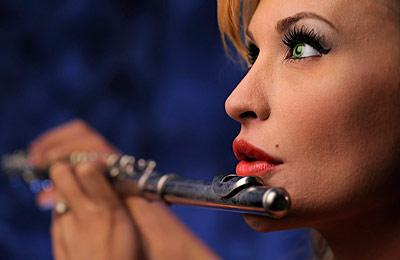 Image #1A The Flutist … The studio is not altogether unfamiliar territory for me and I occasionally secure a client who’s needs involve a very controlled studio environment. When this kind of job comes along I turn to a good friend and colleague, Allison Earnest (see: www.allisonearnestphotography.com … some of you might want to pick up her recent book Sculpting with Light a wonderfully photographed and written instructional book on studio lighting techniques www.amherstmedia.com ) Allison is most generous with her studio and advise when I come calling and so it was with this job. This kind of work is tailor made for the Nikon D3X. What I might lack in studio knowledge I can at least match and perhaps even surpass others merely by producing incredible image quality using this new camera. Here is the original file without any cropping. Nikon D3X, ISO400, 1/800 at f5.0, Nikon 24-70mm lens, WB 3030K, Three Nikon SB-900 Speedlights in i-TTL mode; two SB-900s are in a medium soft box each with the warming gel that comes with each Speedlight, each has a power output of +1.7, the third SB-900 is on the floor by my subjects feet and is pointed up at the cloth backdrop has a power output of -2.3. The cool WB of 3030K makes the backdrop blue while the orange warming gel placed in front of each of the two SB-900s in the soft box brings back a beautiful skin tone to the subject, One Bogen Lightstand with my home-made Speedlight mount for the two SB-900s in the soft box, I used a Nikon SU-800 Commander to trigger all three Speedlights, Lexar 16G Flash Card. Image #1A The Flutist … The studio is not altogether unfamiliar territory for me and I occasionally secure a client who’s needs involve a very controlled studio environment. When this kind of job comes along I turn to a good friend and colleague, Allison Earnest (see: www.allisonearnestphotography.com … some of you might want to pick up her recent book Sculpting with Light a wonderfully photographed and written instructional book on studio lighting techniques www.amherstmedia.com ) Allison is most generous with her studio and advise when I come calling and so it was with this job. This kind of work is tailor made for the Nikon D3X. What I might lack in studio knowledge I can at least match and perhaps even surpass others merely by producing incredible image quality using this new camera. Here is the original file without any cropping. Nikon D3X, ISO400, 1/800 at f5.0, Nikon 24-70mm lens, WB 3030K, Three Nikon SB-900 Speedlights in i-TTL mode; two SB-900s are in a medium soft box each with the warming gel that comes with each Speedlight, each has a power output of +1.7, the third SB-900 is on the floor by my subjects feet and is pointed up at the cloth backdrop has a power output of -2.3. The cool WB of 3030K makes the backdrop blue while the orange warming gel placed in front of each of the two SB-900s in the soft box brings back a beautiful skin tone to the subject, One Bogen Lightstand with my home-made Speedlight mount for the two SB-900s in the soft box, I used a Nikon SU-800 Commander to trigger all three Speedlights, Lexar 16G Flash Card.
|
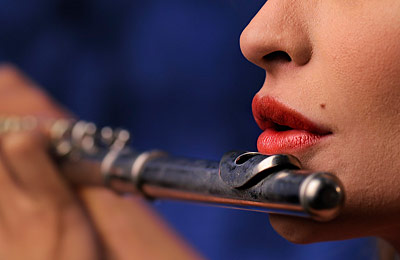 Image #1B The Flutist (cropped detail) … Here is a cropped detail of the original image. I used a short depth of field (f5.0) so as to have only the subjects mouth and eye in focus. The main concentration of the image are the subjects lips and this is were the superior detail of the D3X over a D3 takes the image further with regards to detail for a commercial client. The D3X file has so much detail/information/pixels that cropping an image in Photoshop even as much as this image illustrates, is not only possible but opens up the options for editors considering your work for publication. Image #1B The Flutist (cropped detail) … Here is a cropped detail of the original image. I used a short depth of field (f5.0) so as to have only the subjects mouth and eye in focus. The main concentration of the image are the subjects lips and this is were the superior detail of the D3X over a D3 takes the image further with regards to detail for a commercial client. The D3X file has so much detail/information/pixels that cropping an image in Photoshop even as much as this image illustrates, is not only possible but opens up the options for editors considering your work for publication.
|
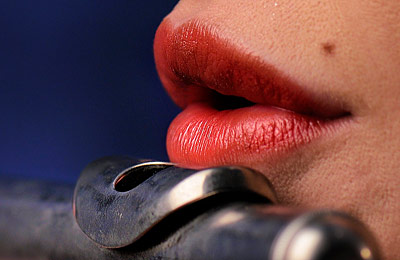 Image #1C The Flutist (cropped detail) … Image #1C The Flutist (cropped detail) … Here is an extreme crop of the original image. The detail is beautiful. All the texture of the subjects lips and the texture of the mouth piece section of the flute look terrific. While some cropping in Photoshop is common in the industry keep in mind that these two cropped images are not suggesting that a photographer shoot excessively loose and then do extreme cropping to make a picture. I’m including these extreme cropped images to illustrate the detail that 24.5 megapixels provides.
|
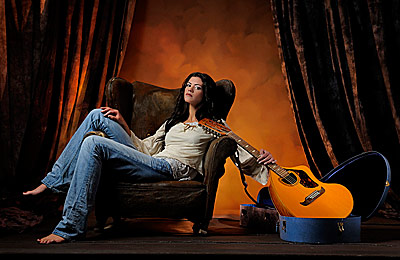 Image #2A Listen Up … Here is another image from the studio shoot. Attitude was more the “look” of this picture and my young subject was perfect for the part. An absolutely delightful young lady to work with, when I asked for a bit of a “attitude” she became the perfect “no nonsense” recording artist for this picture. Four Nikon SB-900 Speedlights were used for this studio set up. There are two SB-900s mounted in a medium soft box just out of the left edge of the frame, there is one SB-900 with a LumaQuest Snoot just out of the right edge of the frame and is aimed at the guitar only, and there is one SB-900 using the wide angle flash adapter (not the diffusion dome) with the warming gel sitting on the floor using the Speedlight Stand placed behind the chair and aimed at the backdrop/drapery. Nikon D3X, ISO320, 1/125 at f14, Nikon 24-70mm lens, WB 5560K, Two SB-900s in a medium soft box with power output of -1.0, One SB-900 with LumaQuest Snoot has a power output of -1.0, One SB-900 on the floor with wide angle spreader and warming gel has a power output of -1.3, One Bogen Lightstand, Lexar 16 G Flash Card. Image #2A Listen Up … Here is another image from the studio shoot. Attitude was more the “look” of this picture and my young subject was perfect for the part. An absolutely delightful young lady to work with, when I asked for a bit of a “attitude” she became the perfect “no nonsense” recording artist for this picture. Four Nikon SB-900 Speedlights were used for this studio set up. There are two SB-900s mounted in a medium soft box just out of the left edge of the frame, there is one SB-900 with a LumaQuest Snoot just out of the right edge of the frame and is aimed at the guitar only, and there is one SB-900 using the wide angle flash adapter (not the diffusion dome) with the warming gel sitting on the floor using the Speedlight Stand placed behind the chair and aimed at the backdrop/drapery. Nikon D3X, ISO320, 1/125 at f14, Nikon 24-70mm lens, WB 5560K, Two SB-900s in a medium soft box with power output of -1.0, One SB-900 with LumaQuest Snoot has a power output of -1.0, One SB-900 on the floor with wide angle spreader and warming gel has a power output of -1.3, One Bogen Lightstand, Lexar 16 G Flash Card.
|
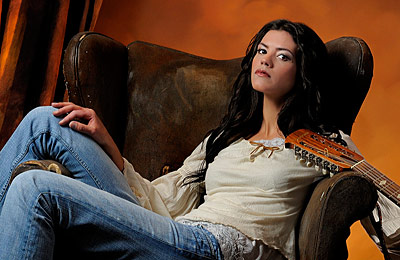 Image #2B Listen Up (cropped detail) … Here is a cropped detail of the original image. Her strands of hair are still full of edge detail and the fibers of her cotton top are also clear and distinct. Her eyelashes look fantastic and the texture of the old winged chair seems to compliment her tough persona. Image #2B Listen Up (cropped detail) … Here is a cropped detail of the original image. Her strands of hair are still full of edge detail and the fibers of her cotton top are also clear and distinct. Her eyelashes look fantastic and the texture of the old winged chair seems to compliment her tough persona.
|
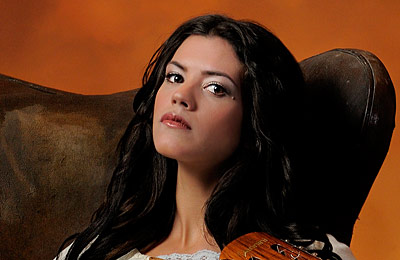 Image #2C Listen Up (cropped detail) … Here is an extreme cropping of the original. The subjects eyelashes are still clearly defined and there is no sign of jagged pixilated edges anywhere. Her edges of her eyes show no sign of pixilization. The weaving of her cotton top looks beautiful and the metal texture of the guitar strings are clean and detailed. This kind of quality is standard in the commercial business, but what’s more important is that it can be achieved with a 35mm camera and not a mid-format system. All my Nikon 35mm gear from lenses to Speedlights is available to me whether I’m shooting in a studio or at a college basketball game and I have medium format image quality. Image #2C Listen Up (cropped detail) … Here is an extreme cropping of the original. The subjects eyelashes are still clearly defined and there is no sign of jagged pixilated edges anywhere. Her edges of her eyes show no sign of pixilization. The weaving of her cotton top looks beautiful and the metal texture of the guitar strings are clean and detailed. This kind of quality is standard in the commercial business, but what’s more important is that it can be achieved with a 35mm camera and not a mid-format system. All my Nikon 35mm gear from lenses to Speedlights is available to me whether I’m shooting in a studio or at a college basketball game and I have medium format image quality. |
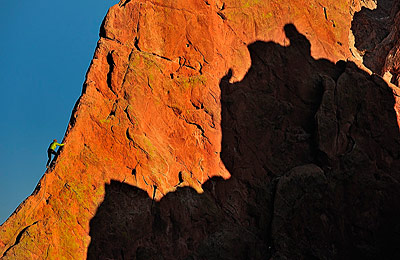 Image #3A Montezuma Incline … OK, let’s get out of the studio and into the great outdoors. Here is world renown climber and extreme climbing film maker Chris Alstrin. Beautiful golden hour sunset light and a terrific shadow. A perfect scene for the D3X. Chris is a long ways away, but the 24.5 megapixel file of the D3X captures all the crusty texture of the Colorado sandstone rock formations in Garden of the Gods. Nikon D3X, ISO500, 1/640 at f7.1, Nikon 200-400mm G VR Zoom lens, WB 4550K, Lexar 16G Flash Card. Image #3A Montezuma Incline … OK, let’s get out of the studio and into the great outdoors. Here is world renown climber and extreme climbing film maker Chris Alstrin. Beautiful golden hour sunset light and a terrific shadow. A perfect scene for the D3X. Chris is a long ways away, but the 24.5 megapixel file of the D3X captures all the crusty texture of the Colorado sandstone rock formations in Garden of the Gods. Nikon D3X, ISO500, 1/640 at f7.1, Nikon 200-400mm G VR Zoom lens, WB 4550K, Lexar 16G Flash Card. |
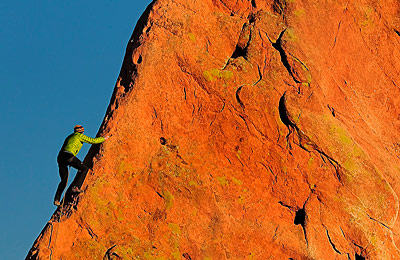 Image #3B Montezuma Incline (cropped detail) … Here is a cropped detail of the original image. Easily publishable, easily printable to a 16X24 or more. There is so much detail it is staggering. The texture and divisions of Chris’s climbing rope is clearly visible with out any jagged pixilated edges. Image #3B Montezuma Incline (cropped detail) … Here is a cropped detail of the original image. Easily publishable, easily printable to a 16X24 or more. There is so much detail it is staggering. The texture and divisions of Chris’s climbing rope is clearly visible with out any jagged pixilated edges. |
 Image #3C Montezuma Incline (cropped Detail) … Here is an extreme cropped detail of the original image. It’s nuts! I can see the stitching in his jacket and stocking cap. Chris’s fingers and eyebrow are clear and distinct. This crop made a fine 11X14. It’s crazy I tell you … CRAZY! Image #3C Montezuma Incline (cropped Detail) … Here is an extreme cropped detail of the original image. It’s nuts! I can see the stitching in his jacket and stocking cap. Chris’s fingers and eyebrow are clear and distinct. This crop made a fine 11X14. It’s crazy I tell you … CRAZY! |
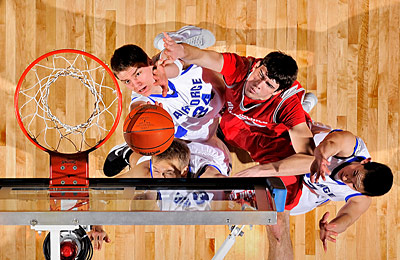 Image #4 Rim Shot … For many years I have covered some of the United States Air Force Academy’s athletic events. First let me say what a joy it is to go out and work at the USAFA facility. Everyone is terrific and helpful. Great pictures always seem to come from their athletes and I consider it a real privilege to work with them. I’ve secured my Nikon D3X as a remote camera located above the basket in the arena catwalk. Usually with remote camera use for basketball coverage a photographer will compose the scene slightly looser than normal in an effort to capture a variety of action under the basket. My original composition included equal space on either side of the basket, but the best picture of the night was this compact cluster of players to the right side. Thanks to the D3X file size of 24.5 megapixels I can crop in on the play and easily have this image used as a two page spread in a magazine or a 16X24 print enlargement for the Athletic Department. The ISO of 800 is very clean and allowed me to use an aperture of f10 which is a huge depth of field that keeps the entire image from the rim to the court sharp. Nikon D3X, ISO800, 1/250 at f10, Nikon 70-200mm zoom, WB 5560K, Remote camera location in the catwalk above the court using Bogen Mini Magic Arm with Bogen Super Clamp and safety cable, the D3X is triggered wirelessly using Pocket Wizard Multi Max Transceiver connected to a Pre-Release Trigger (made by LPA Design and keeps the camera “awake”) which is then connected to the 10 pin port on the D3X, Two Elinchrom Ranger RX Speed AS battery powered packs with sport strobes at 3/4 power are lighting this end of the basketball court and are triggered by the EL-Skyport Transceiver on the D3X hotshoe when the remote camera is fired by me from my courtside photo position, Lexar 16G Flash Card. Oh, I almost forgot, the small print on the basketball reads Size 7 29.5. We are talking detail! Image #4 Rim Shot … For many years I have covered some of the United States Air Force Academy’s athletic events. First let me say what a joy it is to go out and work at the USAFA facility. Everyone is terrific and helpful. Great pictures always seem to come from their athletes and I consider it a real privilege to work with them. I’ve secured my Nikon D3X as a remote camera located above the basket in the arena catwalk. Usually with remote camera use for basketball coverage a photographer will compose the scene slightly looser than normal in an effort to capture a variety of action under the basket. My original composition included equal space on either side of the basket, but the best picture of the night was this compact cluster of players to the right side. Thanks to the D3X file size of 24.5 megapixels I can crop in on the play and easily have this image used as a two page spread in a magazine or a 16X24 print enlargement for the Athletic Department. The ISO of 800 is very clean and allowed me to use an aperture of f10 which is a huge depth of field that keeps the entire image from the rim to the court sharp. Nikon D3X, ISO800, 1/250 at f10, Nikon 70-200mm zoom, WB 5560K, Remote camera location in the catwalk above the court using Bogen Mini Magic Arm with Bogen Super Clamp and safety cable, the D3X is triggered wirelessly using Pocket Wizard Multi Max Transceiver connected to a Pre-Release Trigger (made by LPA Design and keeps the camera “awake”) which is then connected to the 10 pin port on the D3X, Two Elinchrom Ranger RX Speed AS battery powered packs with sport strobes at 3/4 power are lighting this end of the basketball court and are triggered by the EL-Skyport Transceiver on the D3X hotshoe when the remote camera is fired by me from my courtside photo position, Lexar 16G Flash Card. Oh, I almost forgot, the small print on the basketball reads Size 7 29.5. We are talking detail! |
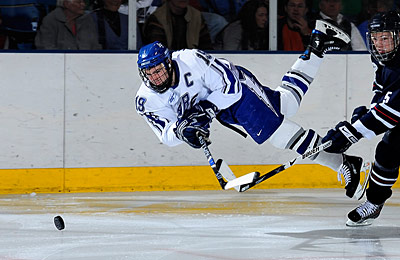 Image #5 Air Hockey … The Air Force Ice Hockey team is having a fantastic season. Ranked in the top 20 the Falcon’s are flying high, especially this player as he makes the shot despite being forced to go airborne. This image was made using a 70-200mm zoom lens and 1.4 Teleconverter and was a bit short on length to reach completely across the rink as my player occupied only about 35% of the actual frame. The D3X with its 24.5 megapixel file did a remarkable job when I cropped the image in Photoshop. The small Atlantic Hockey patch on his jersey is easily legible as is the even smaller word Bauer on the front of his helmet. With much of my sports coverage I strive to make pictures where my athletes are occupying the full frame and I admit it’s new for me to incorporate the idea of cropping to an image in Photoshop, but the Nikon D3X makes it more than possible and a convent option for editors. Nikon D3X, ISO640, 1/250 at f9, Nikon 70-200mm zoom lens and TC14E 1.4 Teleconverter, WB 5000K, Two Elinchrom Ranger RX Speed AS packs with sport strobes at 3/4 power and installed in the arena catwalks above the ice rink using Bogen Super Clamps and safety straps, the Elinchrom Rangers were triggered with the wireless Elinchrom EL-Skyport Transceiver system which allows me to vary the strobe power output directly from Skyport Transceiver on the hotshoe of my camera, Lexar 16G Flash Card. Image #5 Air Hockey … The Air Force Ice Hockey team is having a fantastic season. Ranked in the top 20 the Falcon’s are flying high, especially this player as he makes the shot despite being forced to go airborne. This image was made using a 70-200mm zoom lens and 1.4 Teleconverter and was a bit short on length to reach completely across the rink as my player occupied only about 35% of the actual frame. The D3X with its 24.5 megapixel file did a remarkable job when I cropped the image in Photoshop. The small Atlantic Hockey patch on his jersey is easily legible as is the even smaller word Bauer on the front of his helmet. With much of my sports coverage I strive to make pictures where my athletes are occupying the full frame and I admit it’s new for me to incorporate the idea of cropping to an image in Photoshop, but the Nikon D3X makes it more than possible and a convent option for editors. Nikon D3X, ISO640, 1/250 at f9, Nikon 70-200mm zoom lens and TC14E 1.4 Teleconverter, WB 5000K, Two Elinchrom Ranger RX Speed AS packs with sport strobes at 3/4 power and installed in the arena catwalks above the ice rink using Bogen Super Clamps and safety straps, the Elinchrom Rangers were triggered with the wireless Elinchrom EL-Skyport Transceiver system which allows me to vary the strobe power output directly from Skyport Transceiver on the hotshoe of my camera, Lexar 16G Flash Card. |
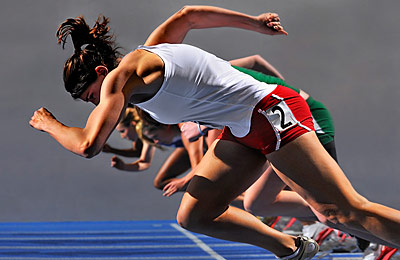 Image #6 Sprint of the Heptathletes … OK, full frame image, no crop. I made this image just today (February 26th) while covering the Mountain West Conference Track and Field Championships. I decided to rush it into this article and make my Workshop at the Ranch deadline for March. Hope you I like it,…I do. The serpentine arm position of the athlete and her thin waistline with muscular upper body is a terrific athletic illustration. I watched her practice coming out of the start blocks during warm-ups and saw the potential for a strong image. Great athletes compete at the High School and Collegiate level each week and some of my favorite images have come from local events. Nikon D3X, ISO640, 1/250 at f5.6, Nikon 70-200mm zoom lens, WB 5560K, Two Elinchrom Ranger RX Speed AS sport strobes triggered by Elinchrom EL-Skyport Transceivers, Bogen Super Clamps to secure the strobes to the catwalk above the track, Lexar 16G Flash Card. Image #6 Sprint of the Heptathletes … OK, full frame image, no crop. I made this image just today (February 26th) while covering the Mountain West Conference Track and Field Championships. I decided to rush it into this article and make my Workshop at the Ranch deadline for March. Hope you I like it,…I do. The serpentine arm position of the athlete and her thin waistline with muscular upper body is a terrific athletic illustration. I watched her practice coming out of the start blocks during warm-ups and saw the potential for a strong image. Great athletes compete at the High School and Collegiate level each week and some of my favorite images have come from local events. Nikon D3X, ISO640, 1/250 at f5.6, Nikon 70-200mm zoom lens, WB 5560K, Two Elinchrom Ranger RX Speed AS sport strobes triggered by Elinchrom EL-Skyport Transceivers, Bogen Super Clamps to secure the strobes to the catwalk above the track, Lexar 16G Flash Card. |
Well, I hope this series of 2 articles helps many of you decide what camera to bring into your business. Although my commercial studio work might not be quite as creative as famed photographer Rob Van Petten, I can at least hold my own in quality. As far as my sports clients are concerned, they are thrilled with the image quality I’m offering. The 24.5 megapixels provides my client with additional freedom to crop and compose and images still have excellent quality to make enlargements, covers, double page spreads, or advertisements. Yes, it’s a price bigger than most photographers will want to pay, but perhaps they haven’t thought of all the benefits. As I said in last month’s article, by setting a new standard of image quality and excellence you can distance yourself from the pack of competitors, and when you separate yourself from your competitors then you have business, and when you have business, well, … the rest, as they say, is history.
See you next time here on Workshop at the Ranch. Adios, Dave
![]() Hi and welcome to this packed edition of Workshop at the Ranch featuring Part II of the NEW Nikon D3X review. I felt the readers of Workshop at the Ranch might want some additional images and commentary on this remarkable piece of equipment. This month’s images are a wide variety ranging from the studio, to climbing along the Front Range of the Rocky Mountains, to indoor sports using the D3X with arena strobe lighting and remote camera work. With Nikon D3X Part I somewhat behind us, let’s review a few things I mentioned last month and then move on to some new pictures.
Hi and welcome to this packed edition of Workshop at the Ranch featuring Part II of the NEW Nikon D3X review. I felt the readers of Workshop at the Ranch might want some additional images and commentary on this remarkable piece of equipment. This month’s images are a wide variety ranging from the studio, to climbing along the Front Range of the Rocky Mountains, to indoor sports using the D3X with arena strobe lighting and remote camera work. With Nikon D3X Part I somewhat behind us, let’s review a few things I mentioned last month and then move on to some new pictures. 













